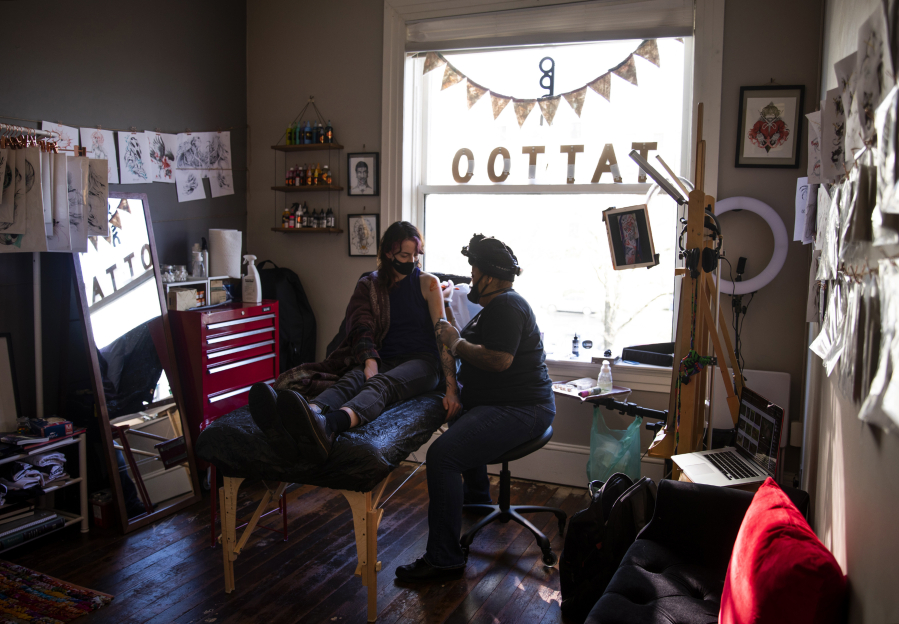Jainai Jeffries’ social media pages for her business read loud and clear that she is a nonbinary female of color, and there’s a specific reason for that.
“The reason I mention my ethnicity, sex and gender is to hopefully bring comfort to clients who have had issues before,” she said.
Raised in Los Angeles, Jeffries, 37, said she never really witnessed issues in the tattoo business concerning sex and racism, at least where she did her apprenticeship.
“It wasn’t until I started; I was on the verge of finding my place in the industry community. I started hearing all these stories of people having issues, especially Black clients; an artist told them they can’t do color on them,” Jeffries said.
Jeffries, a licensed tattoo artist in Washington, said these experiences have made some of her clients anxious.
“One of the things I don’t like of the tattooing community — they seem to ‘other’ the coloring of melanin. But it’s literally just a layer of melanin. That’s all it is,” she said. “They think color won’t show up on us. They make it seem like it’s something wrong with a client, a dark-skinned client.”
But, as Jeffries demonstrates in photos of her work, Black bodies can show color.
“It’s just how you approach it. You just got to do it in a way that will help that person, that particular melanin,” she said. “It’s a discussion that happens like every week.”
She is hoping a style she created called “Blkamflo,” short for Black American Flow, will catch on, but in the Pacific Northwest, the clientele is largely white, so she is planning a move back to her hometown of Los Angeles.
Jeffries moved to the area in April 2016 and while she does tattoos, she also specializes in illustration and comics. She graduated from the University of California Santa Cruz and the School of Visual Arts in New York.
The Columbian caught up with Jeffries to learn more.
Tell me about yourself.
I’m from L.A., and I came to this area in April 2016 for the purpose of opening my own boutique because I like new areas. I don’t really like the idea of spending all my time in my hometown. The 2016 winter was my first winter here. I was like: Oh. I have to stay close to where I live. It took a while. I finally opened in March 2019 and before then my main business was illustration, comics and concept design. I’ve been doing that full-time freelancing, I want to say since 2009 or 2010.
How long have you been illustrating and tattooing, and what got you into it?
It’s only now that I realize concept art I was something I was always interested in. I always loved seeing variations of a character, like with “Fantasia” – the original with the centaurs, I liked seeing the different kinds. It wasn’t until seventh grade when I was playing Final Fantasy 7, when I looked in the back of the book and I saw the term “character designer.” I said “That’s what I want to do.” I didn’t get really serious about it until I was in Japan for a year in an exchange program with my college. It’s like I had an epiphany. I hunkered down. I would skip classes just to finish a piece.
WORKING IN CLARK COUNTY
Working in Clark County, a brief profile of interesting Clark County business owners or a worker in the public, private, or nonprofit sector. Send ideas to Hope Martinez:
hope.martinez@columbian.com; fax 360-735-4598; phone 360-735-4550.
What is “Blkamflo?”
In my tattooing, I’m specialized in my own style – illustrative and what I call flow because I don’t like to call it tribal. I call it “Blkamflo.” It’s basically if Black Americans had our own heritage tattoo. I need a Black American clientele to get that particular style going. What better place to pitch it than L.A.? It’s basically like the regular flow style. It flows with the person’s body but it incorporates the universal symbols – like circles and lines that you see in African cultures. Not anyone specific because they’re all different. I don’t want to assume we’re any one of them, but just to connect to Africa in general would be those universal symbols – circles and lines and such. But to make it us, one would hide words inside the patterns, like Black power, Black epithets. Whatever message the person is connected to.
Why do you think this is important?
I think it would just be interesting. Black America is one of those unique cultures, considering where we sprouted from. I know many of us do appreciate and partake in tattooing, so I’m like what if we had our own heritage tattoo? I don’t like how we feel the need to always guesstimate on where our African part came from. It would be cool if we did know our own roots – but I also love to celebrate our own culture. I feel that should be celebrated as well, considering our influence on the world. We are a part of Africa still and always will be, but we have our own thing too.
How has the pandemic impacted business?
My particular business – it’s really private, even before the pandemic I only took one person a day. I feel that benefitted me because I don’t have coworkers to worry about and protections in that way. I think business got lighter. I can’t really tell if it wasn’t for the pandemic if I’d have more or even less. Maybe if I were in my third year I could tell. It happened too soon for me to really have a good frame of reference.
So you have tattoos, and you give them. What is yours? Why do you think people get tattoos or find them to be something they want to spend money on?
I only have one, but it’s my full sleeve on my left arm and hand. It’s of a long-tailed rooster. The artist is Stace Forand in Vancouver, B.C. I would never just get a small tattoo. I think they’re an art form. That’s like asking “Why is art important?” People appreciate both artistry and pain. They want something that’s life reflective. The reasons are numerous. I can only speak for myself.




